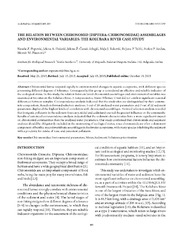Приказ основних података о документу
The relation between chironomid (Diptera: Chironomidae) assemblages and environmental variables: The Kolubara River case study
| dc.creator | Popović, Nataša | |
| dc.creator | Đuknić, Jelena | |
| dc.creator | Čanak Atlagić, Jelena | |
| dc.creator | Raković, Maja | |
| dc.creator | Tubić, Bojana | |
| dc.creator | Anđus, Stefan | |
| dc.creator | Paunović, Momir | |
| dc.date.accessioned | 2019-11-08T08:56:18Z | |
| dc.date.available | 2019-11-08T08:56:18Z | |
| dc.date.issued | 2016 | |
| dc.identifier.issn | 0354-4664 | |
| dc.identifier.uri | http://www.serbiosoc.org.rs/arch/index.php/abs/article/view/783 | |
| dc.identifier.uri | https://radar.ibiss.bg.ac.rs/handle/123456789/3497 | |
| dc.description.abstract | Chironomid larvae respond rapidly to environmental changes in aquatic ecosystems, with different species possessing different degrees of tolerance. Consequently, this group is considered an effective and reliable indicator of the ecological status. In this study, the relation between larval chironomid assemblages and environmental variables was examined at two sites on the Kolubara River. The nonparametric Mann-Whitney U test did not confirm significant seasonal differences between samples. Correspondence analysis indicated that the study sites are distinguished by their community composition. Based on forward selection analyses, 5 out of the 28 analyzed water parameters and 3 out of the 22 sediment parameters displayed the highest levels of correlation with chironomid assemblages. Forward selection analysis revealed that inorganic pollutants in the sediment (mercury, nickel and cadmium) exerted the greatest influence on the community. Results of canonical correspondence analysis indicated that the sediment characteristics have a more significant impact on chironomid communities than the analyzed water parameters. Our study confirmed that chironomids and sediment analyzes should be obligatorily included in the monitoring of ecological status, since chironomids are often a dominant component of benthic macroinvertebrate assemblages in freshwater ecosystems, with many species inhabiting the sediment with a proclivity for intake of toxic and persistent pollutants. | en |
| dc.language.iso | en | sr |
| dc.publisher | Serbian Biological Society | sr |
| dc.relation | info:eu-repo/grantAgreement/MESTD/Basic Research (BR or ON)/176018/RS// | sr |
| dc.relation | info:eu-repo/grantAgreement/MESTD/Basic Research (BR or ON)/173025/RS// | sr |
| dc.relation | info:eu-repo/grantAgreement/EC/FP7/603629/EU// | sr |
| dc.rights | openAccess | sr |
| dc.rights.uri | https://creativecommons.org/licenses/by-nc-nd/4.0/ | |
| dc.source | Archiv of Biological Science | sr |
| dc.subject | Chironomidae | sr |
| dc.subject | Environmental parameters | sr |
| dc.subject | Water | sr |
| dc.subject | Sediment | sr |
| dc.subject | Pollutants prioritization | sr |
| dc.title | The relation between chironomid (Diptera: Chironomidae) assemblages and environmental variables: The Kolubara River case study | en |
| dc.type | article | sr |
| dc.rights.license | BY-NC-ND | sr |
| dcterms.abstract | Чанак Aтлагић, Јелена; Тубић, Бојана; Ђукнић, Јелена; Поповић, Наташа; Aнђус, Стефан; Пауновић, Момир; Раковић, Маја; | |
| dc.rights.holder | © Serbian Biological Society | sr |
| dc.citation.issue | 2 | |
| dc.citation.volume | 68 | |
| dc.identifier.doi | 10.2298/ABS150521123P | |
| dc.identifier.scopus | 2-s2.0-84971014939 | |
| dc.identifier.wos | 000377883900018 | |
| dc.citation.spage | 405 | |
| dc.citation.epage | 415 | |
| dc.type.version | publishedVersion | sr |
| dc.identifier.fulltext | https://radar.ibiss.bg.ac.rs/bitstream/id/5550/bitstream_5550.pdf | |
| dc.citation.rank | M23 |

